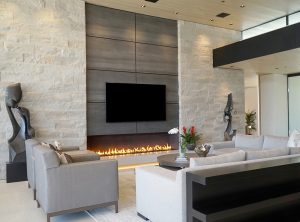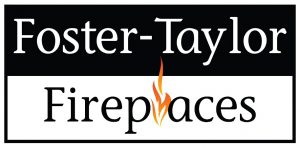When it comes to selecting a fireplace, understanding the different options available is key to making an informed decision. Fireplaces not only serve as a source of warmth but also add a cozy ambiance to your living space. Whether you’re looking for efficiency, ease of installation, or the perfect aesthetic, here’s a breakdown of the main types of fireplaces to help you decide which one is best for your home.
Direct-Vent Fireplaces
How It Works:
Direct-vent fireplaces are designed to be both efficient and safe. They use a double-vent pipe system: one pipe draws in fresh air from outside for combustion, while the other expels exhaust fumes back outdoors. This setup ensures that no indoor air is used or contaminated, making it an excellent option for maintaining indoor air quality.
In the Home:
Thanks to their straightforward venting system, direct-vent fireplaces can be installed on almost any wall in your home. If a wall installation isn’t feasible, the system can be vented through the roof, offering versatility in placement. Additionally, direct-vent fireplaces are highly fuel-efficient, converting almost all the gas or propane they use into usable heat.
Pros:
- Efficient use of fuel with minimal heat loss.
- Sealed from external elements, ensuring clean indoor air.
- Flexible installation options, including wall or roof venting.
Cons:
- Sealed glass front limits flame size and log arrangement.
- Slightly higher cost for vent pipe installation.
Vent-Free Fireplaces
How It Works:
As the name suggests, vent-free fireplaces do not require any external venting. They draw air from the room for combustion and release heat back into the room, making them 100% efficient. However, because these units rely on indoor air, they need to be used in larger rooms with good ventilation to prevent carbon monoxide buildup.
In the Home:
Vent-free fireplaces offer unparalleled installation flexibility, allowing you to place them in tight or unconventional spaces. Their lack of a venting system means no heat is lost through vents, making them an ideal choice for efficiently heating a room. However, they are best suited for larger rooms with ample air circulation.
Pros:
- No heat loss, making them extremely efficient.
- Versatile installation options without the need for venting.
- More environmentally friendly with nearly complete fuel combustion.
Cons:
- Limited customization of log arrangement.
- Potential for increased room humidity and related issues.
- Not allowed in some regions due to local regulations.
B-Vent Fireplaces
How It Works:
B-vent fireplaces function similarly to traditional wood-burning fireplaces. They draw air from inside the room for combustion and vent the exhaust through a chimney. While they still use gas or propane, they are less efficient than direct-vent or vent-free models due to potential heat loss through the chimney.
In the Home:
B-vent fireplaces require a chimney for proper venting, which can limit installation options to areas of the home with existing chimneys or where a new chimney can be installed. This type of fireplace is less efficient, as some heat may be lost up the chimney, and cold drafts can occasionally enter the home.
Pros:
- Combustion fumes are safely vented outside.
- Relatively simple and inexpensive venting installation.
- Can be used with existing wood-burning fireplaces.
Cons:
- Requires a chimney, limiting installation flexibility.
- Potential for cool air drafts and heat loss.
- Less efficient compared to direct-vent and vent-free options.
Vented Gas Logs
How It Works:
Vented gas logs are designed for use in existing wood-burning fireplaces. They create realistic flames that wrap around the logs, closely mimicking a traditional wood fire. However, they require an open chimney or flue to vent carbon monoxide and other combustion byproducts.
In the Home:
Vented gas logs are ideal for homeowners who want the look of a real wood fire without the hassle of burning wood. While they are more decorative than functional, they can still provide some warmth. However, because they vent through a chimney, much of the heat escapes, making them less efficient than vent-free options.
Pros:
- Offers the most realistic flame appearance.
- Can be used in an existing wood-burning fireplace.
- Allows for some customization with decorative accessories.
Cons:
- Less heat output due to venting through the chimney.
- Requires a fully functioning wood-burning fireplace.
- Produces more soot and requires regular cleaning.
Choosing the Right Fireplace for Your Needs
When selecting a fireplace, consider your specific needs and preferences:
- For maximum efficiency and versatility: A direct-vent fireplace is an excellent choice, offering flexible installation options and high heat output with minimal heat loss.
- For installation flexibility and 100% efficiency: A vent-free fireplace is ideal, especially in larger rooms with good ventilation.
- For a traditional look with some modern convenience: B-vent fireplaces and vented gas logs provide a more authentic wood-burning experience, though they may sacrifice some efficiency.
No matter which option you choose, understanding how each type of fireplace works and the benefits they offer will ensure you select the perfect heating solution for your home.
